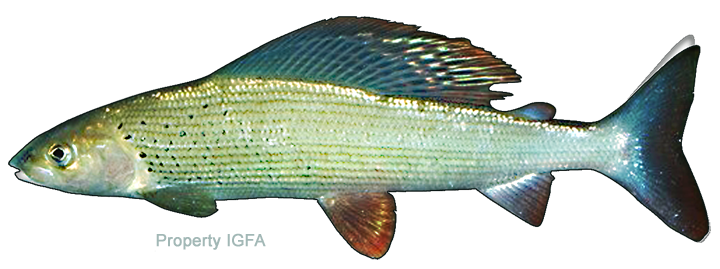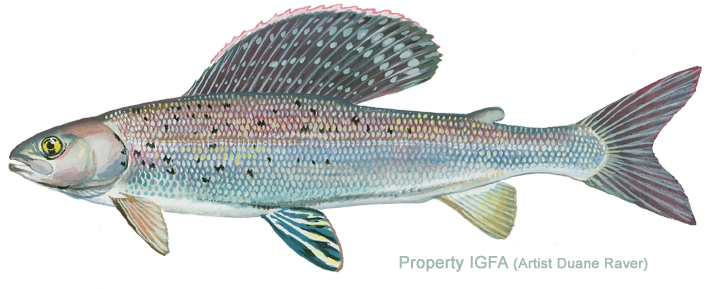Game Fish Identification Reference Guides
Grayling
(Thymallus thymallus)
(Thymallus thymallus)

(Linnaeus, 1758); SALMONIDAE FAMILY; also called European grayling, kharius, asch, stalling, temolo
Occurs in northern Europe from England and France to the Ural Mountains in northwest Russia in temperature ranges of 18.0-24.0 °C. The grayling is essentially a river fish and prefers clear, well-oxygenated water in the upper reaches of rivers with sand or gravel bottom. It also occurs in lakes, especially in mountain regions and rarely in brackish water (Baltic).
Like its North American counterpart, it is easily recognized by its distinctive sail like dorsal fin, which is followed by a small adipose fin that identifies this fish as a salmonid. A stikingly colored fish; the dorsal surface is steel blue shading to silvery-green on the sides and silver ventrally. The sides of the body have stripes of violet and in breeding season, the colors are heightened with the dorsal fin having an orange-red margin.
Grayling feed mainly on bottom-living insects larvae, especially sedentary caddis worms and the larvae and pupae of midges. It is considered a good game –fish with fly and spinner in Europe. The grayling is a good food fish and highly esteemed in parts of Europe, but is best prepared and eaten fresh as its special flavor is lost a few hours after death. The name thymallus refers to the thyme-like scent of the fish
Occurs in northern Europe from England and France to the Ural Mountains in northwest Russia in temperature ranges of 18.0-24.0 °C. The grayling is essentially a river fish and prefers clear, well-oxygenated water in the upper reaches of rivers with sand or gravel bottom. It also occurs in lakes, especially in mountain regions and rarely in brackish water (Baltic).
Like its North American counterpart, it is easily recognized by its distinctive sail like dorsal fin, which is followed by a small adipose fin that identifies this fish as a salmonid. A stikingly colored fish; the dorsal surface is steel blue shading to silvery-green on the sides and silver ventrally. The sides of the body have stripes of violet and in breeding season, the colors are heightened with the dorsal fin having an orange-red margin.
Grayling feed mainly on bottom-living insects larvae, especially sedentary caddis worms and the larvae and pupae of midges. It is considered a good game –fish with fly and spinner in Europe. The grayling is a good food fish and highly esteemed in parts of Europe, but is best prepared and eaten fresh as its special flavor is lost a few hours after death. The name thymallus refers to the thyme-like scent of the fish













